Gregory A. Fournier's Blog, page 29
March 21, 2016
Allegory of Spring - La Primavera
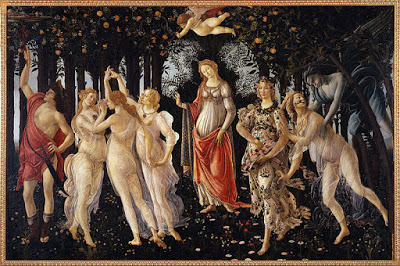
One of the loveliest expressions of springtime is the early Renaissance painting La Primavera (aka. Allegory of Spring) meaning literally "first green" by Italian painter Sandro Botticelli. It is believed he painted it in 1482. The painting hangs in the Uffizi Galley in Florence, Italy, and is a prized Italian national treasure.
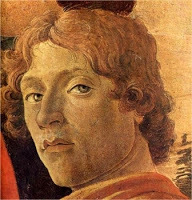 Botticelli self-portrait at age thirty in 1475,Botticelli took his inspiration from the classical writing of the Roman Ovid and his description of spring. The central figure is Venus. To the right of the painting, the blue and chilly Zephyrus catches Flora and impregnates her and she morphs into a fertility figure. To the left, the Three Graces--Charm, Beauty, and Joy--dance as Mercury holds the clouds back from Venus' realm. A blindfolded Cupid seems up to mischief. That's what I see anyway.
Botticelli self-portrait at age thirty in 1475,Botticelli took his inspiration from the classical writing of the Roman Ovid and his description of spring. The central figure is Venus. To the right of the painting, the blue and chilly Zephyrus catches Flora and impregnates her and she morphs into a fertility figure. To the left, the Three Graces--Charm, Beauty, and Joy--dance as Mercury holds the clouds back from Venus' realm. A blindfolded Cupid seems up to mischief. That's what I see anyway.For a more detailed analysis of the painting, check out this short link: https://www.khanacademy.org/humanities/renaissance-reformation/early-renaissance1/painting-in-florence/v/botticelli-la-primavera-spring-1481-1482
Published on March 21, 2016 09:10
March 1, 2016
The Missing John Norman Collins Trial Transcripts
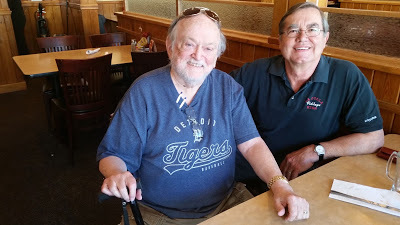 Dr. Paul McGlynn and me--February 2016.Last week, I flew to Florida to visit my former English professor from Eastern Michigan University--Dr. Paul McGlynn. He earned his doctorate degree at Rice University in Texas and taught at Eastern Michigan for thirty-seven years, including the years during the Washtenaw County sex-slayings in the late 1960s.
Dr. Paul McGlynn and me--February 2016.Last week, I flew to Florida to visit my former English professor from Eastern Michigan University--Dr. Paul McGlynn. He earned his doctorate degree at Rice University in Texas and taught at Eastern Michigan for thirty-seven years, including the years during the Washtenaw County sex-slayings in the late 1960s.We hadn't seen one another for forty years, but I knew Paul McGlynn had attended every court session of the John Norman Collins' trial and taken notes of the proceedings. His goal was to write a novel loosely based on the Collins' trial.
Author Edward Keyes was fresh off his success with the novel and movie The French Connection. As part of a multi-book contract, Keyes learned of the Collins' trial and the unsolved murders. He contracted with Simon and Schuster to write The Michigan Murders.
McGlynn read about Keyes' project in the Ann Arbor News, contacted him, and offered to help research his book. For an undisclosed stipend, McGlynn gave Keyes access to his trial notes. Much of what Keyes wrote regarding the trial comes directly from McGlynn's notes, and he gives McGlynn an acknowledgement in the introduction to The Michigan Murders.
Edward Keyes made a significant editorial decision to use pseudonyms for the seven victims, their killer, and the witnesses. The overall effect was to obscure their identities and cloud the history behind these cases. Forty years later, people who lived through those times and were familiar with people involved with this case become confused after reading Keyes' novelization.
 A debt is owed to history to get the facts straight. The Collins' trial was the longest and most expensive criminal proceeding in Washtenaw County history. After Collins' lawyers exhausted every appeal, the Supreme Court of the United States upheld the constitutionality of Collins' life sentence for first-degree murder. The high court returned the trial transcripts on April 19th, 1974. After that date, no mention of the transcripts is made in the county record log book.
A debt is owed to history to get the facts straight. The Collins' trial was the longest and most expensive criminal proceeding in Washtenaw County history. After Collins' lawyers exhausted every appeal, the Supreme Court of the United States upheld the constitutionality of Collins' life sentence for first-degree murder. The high court returned the trial transcripts on April 19th, 1974. After that date, no mention of the transcripts is made in the county record log book.After my researcher Ryan M. Place made an exhaustive statewide Freedom of Information search, the only response we received was from the Washtenaw County Clerk saying the records were "purged" in the mid-seventies. Why the county officials purged the trial transcripts is unknown. Surely, the historical significance of the case warrants that the public record be preserved somewhere--either in print or digitally.
Whether these documents were shredded for shelf space, misplaced through institutional neglect, or destroyed willfully to obfuscate the public record, the bottom line is they are missing. Meeting with Paul McGlynn was a unique opportunity to speak with someone who attended every court session. Collins is the only other person I know who was in court for all of the sessions, but he isn't talking.
My treatment of the trial is based on hundreds of vintage newspaper articles and interviews with some of the trial participants. The quoted dialogue from the daily reports is surprisingly detailed and helped me reconstruct the lost Collins' trial and the legal maneuvering that went on inside and outside the courtroom. Thank goodness for the press.
I asked Paul McGlynn if he would read my manuscript and question or comment on anything. I was most interested in his response to the trial. Here is what he wrote: "I'm wondering how you got the details of the trial so exactly. Did you finally manage to round up a transcript? It reads like a transcript, though of course much abbreviated. It brought back many memories of the long hours spent in the courtroom. Kudos."
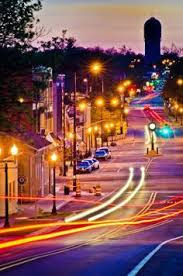 East Cross Street/Depot Town/Water TowerRather than dress-up this dark episode in Ypsilanti's history as narrative nonfiction, I decided to take a terse journalistic approach and retell the events as they happened. The facts and conflicts are enough to carry the story line without manufacturing melodrama.
East Cross Street/Depot Town/Water TowerRather than dress-up this dark episode in Ypsilanti's history as narrative nonfiction, I decided to take a terse journalistic approach and retell the events as they happened. The facts and conflicts are enough to carry the story line without manufacturing melodrama.With any luck, Terror in Ypsilanti: John Norman Collins Unmasked should be available in July 2016. I decided to change the title to make the book more suitable for internet searches.
Published on March 01, 2016 07:13
February 7, 2016
The Dutch Psychic--Peter Hurkos
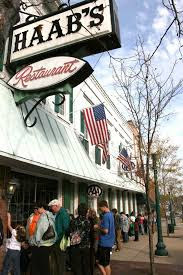 I was just settling into an interview with someone who knew John Norman Collins. It was a late lunch meeting at Haab's--downtown Ypsilanti's oldest and finest restaurant. I overheard two women, sitting in a booth adjacent to us, talking in hushed tones about John Collins and those times. What a coincidence!
I was just settling into an interview with someone who knew John Norman Collins. It was a late lunch meeting at Haab's--downtown Ypsilanti's oldest and finest restaurant. I overheard two women, sitting in a booth adjacent to us, talking in hushed tones about John Collins and those times. What a coincidence!After the lunch crowd, the restaurant was almost empty, so I interjected myself into their conversation. "Ladies! I'm in town this week doing research and interviewing people for a book I'm writing about John Norman Collins."
Both ladies said in unison, "Really?" One of the women had worked for the county police as a dispatcher at that time, and the other claimed to be a psychic.
"How amazing is this?" I said. "I just learned something new about Peter Hurkos--the Danish psychic who was summoned onto the unsolved murdercases by an Ann Arbor citizens' group."
"He helped solve the Boston Strangler case, didn't he," the lady psychic added.
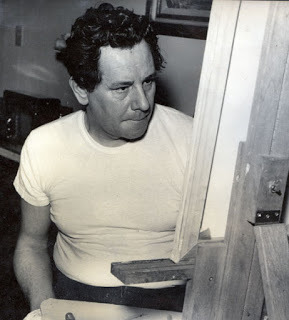 Peter Hurkos being fingerprinted."Not really," I said. "He played a controversial role in that case. Boston police arrested him for impersonating an officer when he aggressively interrogated an emotionally disturbed man. He was told to leave town or face a judge.
Peter Hurkos being fingerprinted."Not really," I said. "He played a controversial role in that case. Boston police arrested him for impersonating an officer when he aggressively interrogated an emotionally disturbed man. He was told to leave town or face a judge.Back in Los Angeles, he parlayed his experience into a nightclub act. Hurkos entered the coed killing media circus in an attempt to punch up his waning career."
Hurkos was hired for one day as a consultant for the disturbing Tony Curtis movie The Boston Strangler--a film John Collins was obsessed with. Years later, Hurkos was hired to appear in a cameo role in the movie version of the Collins' killings entitled Now I Lay Me Down to Sleep--which began filming in 1969 but was never released.
I explained to the ladies, "Mr. Archie Allen--head of an Ann Arbor citizens' group--offered Peter Hurkos $1,100 for expenses to come down from LA to look into this case. Hurkos asked for $2,500 plus expenses and was insulted when the group could not raise more money. He reluctantly agreed to come anyway because of all the potential free publicity generated from this case--especially if he got lucky and helped solve it."
"The man had powers," the lady psychic insisted. "He was a painter who fell off a ladder and banged his head, or something like that. I don't remember exactly. From then on, he could sense people and events from handling their things. He had the gift."
"Yes, I know. That was his claim to fame."
The former police dispatcher added, "Yes, that's right. I remember Lieutenant William Mulholland--an investigator on the case--saying, "He (Hurkos) is making a believer out of me."
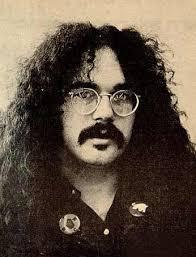 John SinclairWell," I continued, "do you know who the citizens' group was?" I gave the psychic another chance to divine the answer. She could not.
John SinclairWell," I continued, "do you know who the citizens' group was?" I gave the psychic another chance to divine the answer. She could not."Remember, John Sinclair? He was always in trouble with the Washtenaw County sheriff."
"Yes, we do!"
"Sinclair and a bunch of his followers were tired of the police harassment they were getting, so they offered to help. They wanted to show they were responsible, caring members of the Ann Arbor community. One of their members said she thought there might be something cosmic or supernatural going on with this case, so why not try to get a psychic involved?"
"That's interesting," the women agreed
"My theory is they wanted to throw a wildcard into the mix and make the police look stupid. Soon afterwards, the Washtenaw County police were called the Keystone Kops by the Detroit Free Press."
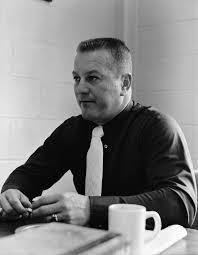 Sheriff Douglas Harvey"I remember how upset Sheriff Harvey was with that reporter," the former dispatcher said.
Sheriff Douglas Harvey"I remember how upset Sheriff Harvey was with that reporter," the former dispatcher said."Harvey did take it personally," I agreed. "I also discovered John Collins came into close contact with Hurkos just before Hurkos left town for LA. Peter Hurkos did not have the slightest clue. I got that information from someone who was there with Collins."
Published on February 07, 2016 08:11
January 29, 2016
Detroit's Lost Neighborhoods--Black Bottom and Paradise Valley
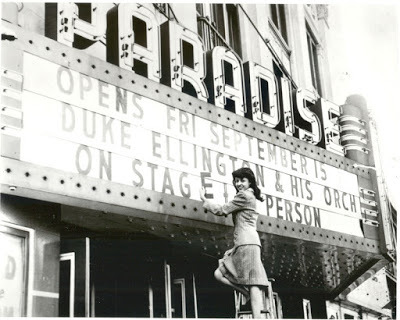
If suburban Detroit residents were asked what they know about Black Bottom and Paradise Valley, most of them would be clueless. Both of these African-American neighborhoods were paved over in the early 1960s in the name of urban renewal. Rather than upgrade housing and services in those established neighborhoods, city fathers--in league with the Federal Highway Commission--cut an unnecessary 1.06 mile long swatch for Interstate 375 through the heart of these black neighborhoods. The Walter P. Chrysler Freeway is the shortest stretch of Interstate in the state of Michigan.
The Savoyard River ran through the area known as Black Bottom (Fond Noir). The fertile land was named by the original eighteenth century French land grant owners. The area was notable for its dark, rich topsoil. In 1827, the river became part of the Detroit sewer system and was bricked over, covered with fill dirt, and built over. The place name initially carried no racial connotation.
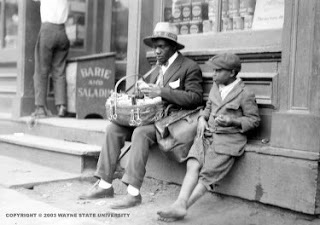 In the twentieth century, Hastings and Antoine Streets were the commercial backbone of Black Bottom and Paradise Valley. After World War I, the established Jewish community began to vacate the area moving west and north of downtown Detroit. Blacks migrating from the South seeking opportunity and factory jobs moved into the aging and inexpensive neighborhood along Hastings Street. In time, African-American entrepreneurs moved into vacated businesses and opened doctors' offices, infirmaries, bakeries, grocery stores, clothing stores, barber shops, beauty salons, bowling alleys, restaurants and hotels serving a vibrant, self-contained, segregated community.
In the twentieth century, Hastings and Antoine Streets were the commercial backbone of Black Bottom and Paradise Valley. After World War I, the established Jewish community began to vacate the area moving west and north of downtown Detroit. Blacks migrating from the South seeking opportunity and factory jobs moved into the aging and inexpensive neighborhood along Hastings Street. In time, African-American entrepreneurs moved into vacated businesses and opened doctors' offices, infirmaries, bakeries, grocery stores, clothing stores, barber shops, beauty salons, bowling alleys, restaurants and hotels serving a vibrant, self-contained, segregated community.The red-line boundaries for the racially isolated community were east of Brush Street, west of the Grand Trunk railroad tracks, south of Gratiot Avenue, and north from the Detroit River. In 1919, jazz composer and musician Jelly Roll Morton named the "Black Bottom Stomp" after the area. Soon, the Black Bottom dance overtook the Charleston in popularity during the 1920s.
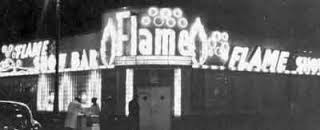
Paradise Valley began north of Gratiot Avenue to Grand Boulevard. This area was the entertainment zone for Detroit's blues and jazz music scene from the 1930s through the 1950s. It was also the center of African-American social life. Places like the Horseshoe Lounge, Club Plantation, Club 666, The Paradise Theater, and The Flame Show Bar with its blazing red and yellow neon sign lit up the street at night.
The likes of Ethel Waters, Pearl Bailey, Billie Holiday, Dizzy Gillespie, Cab Calloway, Count Basie, Ella Fitzgerald, Duke Ellington, Della Reese, and Red Fox were among Paradise Valley's long list of headliners. Traveling African-American performers loved playing Detroit because they could stay at the Gotham Hotel--one of the only first-class hotels in America that served the black community.
Gambling was big business through the Great Lakes Mutual Numbers House and the Frog Club. Whites and blacks mixed comfortably in Paradise Valley until the 1943 race riots. After that, it was rare to see whites venturing into the area--except to cruise for female companionship.
With the passage of the Federal Interstate Highway Act of 1956, the die was cast for the demolition of a long list of urban communities across the country. In Detroit, over 3,500 dwellings and 300 black-owned businesses were condemned and bulldozed tearing apart the social fabric of the community. The Chrysler Freeway opened in June of 1964 paving over Hastings Street and destroying the culture of its inhabitants. Today, Ford Field and Comerica Park stand where once a thriving community lived.
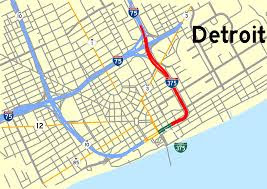 The Michigan Department of Transportation (MDOT) announced in 2013 it is considering a plan by urban planners to remove I-375. Research data shows the I-75 spur is underutilized and could be replaced with a boulevard to make the area more pedestrian and neighborhood friendly.
The Michigan Department of Transportation (MDOT) announced in 2013 it is considering a plan by urban planners to remove I-375. Research data shows the I-75 spur is underutilized and could be replaced with a boulevard to make the area more pedestrian and neighborhood friendly.The unspoken truth is downtown Detroit real estate is just too valuable and begs for redevelopment. This MDOT pronouncement comes sixty years too late for people who remember Black Bottom and Paradise Valley back in the day.
Victoria Spivey and "The Detroit Moan" (1936): https://youtu.be/pKGuHCWWYU0
Published on January 29, 2016 07:39
January 21, 2016
Doctor Who--Madman in a Blue Box

I may be the last person on the planet to discover the British cult science fiction series Doctor Who, but I am trying to make up for it by binge-watching every episode made during the last nine seasons. For other viewers who came late to the series, here is some background and a brief sketch of what the program is about.
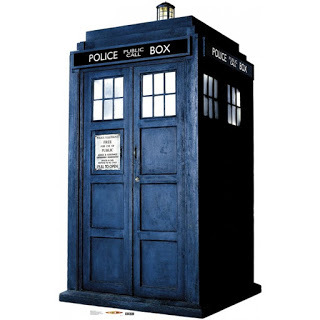 TARDISThe Doctor is a the last surviving Time Lord from the destroyed planet of Gallifrey, exploring the universe in a blue police call box called the TARDIS (Time and Relative Dimension in Space). His mission is to prevent evil intergalactic forces from harming innocent people or changing history. He uses his superior alien intelligence, mind-boggling ingenuity, a lot of running, and a sonic screwdriver.
TARDISThe Doctor is a the last surviving Time Lord from the destroyed planet of Gallifrey, exploring the universe in a blue police call box called the TARDIS (Time and Relative Dimension in Space). His mission is to prevent evil intergalactic forces from harming innocent people or changing history. He uses his superior alien intelligence, mind-boggling ingenuity, a lot of running, and a sonic screwdriver.Doctor Who began as a BBC series in 1963 and ran through 1989. A made-for-television movie in 1996 did poorly, so plans for reviving the series stalled. The program was reincarnated--or should I say regenerated--in 2005 and is still in production. The original intent of Doctor Who was to be an educational family program exploring scientific ideas and famous moments from history. There have been 826 installments televised since the program's inception, though many of the1964 through 1993 episodes were destroyed, wiped from video tape, or deteriorated from neglect. Once the current show found its new audience, it became an international sensation.
 One key to the success of the Doctor is his ability to regenerate himself when his body is mortally damaged. Regeneration was not part of the original concept for the character, but when William Hartnell--the first Doctor Who--became too ill to continue with the role, Patrick Troughton took over. The transformation was described as the Doctor undergoing a "renewal." The concept of regeneration was written into the script for the casting of the third Doctor, and it remains a successful device for recasting the main character.
One key to the success of the Doctor is his ability to regenerate himself when his body is mortally damaged. Regeneration was not part of the original concept for the character, but when William Hartnell--the first Doctor Who--became too ill to continue with the role, Patrick Troughton took over. The transformation was described as the Doctor undergoing a "renewal." The concept of regeneration was written into the script for the casting of the third Doctor, and it remains a successful device for recasting the main character.There have been thirteen actors to play the Time Lord on screen: William Hartnell (1963-1966), Patrick Troughton (1966-1969), Jon Pertwee (1970-1974), Tom Baker (1974-1981), Peter Davidson (1982-1984), Colin Baker (1984-1986), Slyvester McCoy (1987-1989), Paul McGann (1996), Christopher Eccleston (2005), David Tennant (2005-2010), Matt Smith (2010-2013), and Peter Capaldi (2014 to the present).
But the Doctor alone is arrogant, demanding, and largely indifferent to human emotion. His alien perspective clashes with human values, but he learns to admire human beings and develops empathy from them. To balance his abrasive personality, Doctor Who typically travels with a companion or sometimes two or three. Occasionally, he goes it alone. His female time traveler companions serve to soften the doctor's austere intergalactic view. The companion figure is an audience surrogate to remind the Doctor of his "moral duty." They are characters with whom the audience can identify.
 Some of Doctor Who's companions.In the latest series, Rose Tyler (Billie Piper) is the first and second doctor's companion. Her character is a nineteen-year-old shop assistant. Next comes Martha Jones (Freema Agyeman)--a medical student kidnapped by aliens. My personal favorite is Donna Noble (Catherine Tate)--an office temp worker from Chiswick. Other notable characters are Mickey Smith (Noel Clarke), Sarah Jane Smith (Elisabeth Sladen), and Clara Oswald (Jenna Coleman). Fellow time travelers include River Song (Alex Kingston) and Jack Harkness (John Barrowman). These characters often weave in and out of the story lines.
Some of Doctor Who's companions.In the latest series, Rose Tyler (Billie Piper) is the first and second doctor's companion. Her character is a nineteen-year-old shop assistant. Next comes Martha Jones (Freema Agyeman)--a medical student kidnapped by aliens. My personal favorite is Donna Noble (Catherine Tate)--an office temp worker from Chiswick. Other notable characters are Mickey Smith (Noel Clarke), Sarah Jane Smith (Elisabeth Sladen), and Clara Oswald (Jenna Coleman). Fellow time travelers include River Song (Alex Kingston) and Jack Harkness (John Barrowman). These characters often weave in and out of the story lines.The special effects and imaginative settings display a hallmark of technical achievement easily the rival of a Hollywood blockbuster. The exterior camera work is stellar often showing sweeping panoramas of London in all that city's splendor. The show's attention to detail with costumes and makeup in their period-piece episodes helps the actors make their roles plausible. The historically themed shows are often filmed at famous London locations--such as the Old Globe Theatre or Chuchill's Underground War Rooms--giving those shows added believability.
Doctor Who's writers often reveal a plucky British sense of humor and sly wit, with an occasional dose of comic relief. When the Doctor drops in on the likes of Shakespeare, Charles Dickens, or Agatha Christie, the scripts are particularly witty. Despite the intricate and farcical plot complications, Doctor Who's core values are respect for the interconnectedness of all existence and the sanctity of life--human or otherwise. The writers always manage to bring the story line down to a human level and often leave the audience with a tear in their eyes and a lump in their throats.
Doctor Who trailer for the latest season: https://www.youtube.com/user/doctorwho
Published on January 21, 2016 05:57
January 11, 2016
The Rainy Day Murders Progress Report
 Over the past year, the question I was asked most is "When will The Rainy Day Murders be finished?"
Over the past year, the question I was asked most is "When will The Rainy Day Murders be finished?"For the last five years with the help of Ryan M. Place, I have researched and rewritten the entire manuscript three times and consulted editors twice. My original 144,000 word manuscript was too long and the narrative wandered. Publishing length guidelines for true crime range from 80,000 to 100,000 words.
In 2015, I set a personal goal to finish a top-to-bottom restructuring before the end of year. On New Year's Eve, I dotted the last i and crossed the last t. I managed to trim 35,000 words off the manuscript while improving the narrative flow.
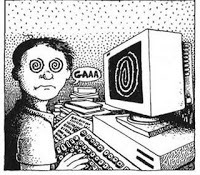 The eye sees but doesn't see itself.Over the past year, I asked five people to read and evaluate The Rainy Day Murders. Several of them commented on the title. They felt rain was not a factor in some of the seven murders. Fair enough. Currently, I am pitching the project using my original title In the Shadow of the Water Tower. What the final title becomes will be decided at some future editorial meeting.
The eye sees but doesn't see itself.Over the past year, I asked five people to read and evaluate The Rainy Day Murders. Several of them commented on the title. They felt rain was not a factor in some of the seven murders. Fair enough. Currently, I am pitching the project using my original title In the Shadow of the Water Tower. What the final title becomes will be decided at some future editorial meeting.Beginning with the San Diego State University Writers' Conference on January 22nd, I will begin pitching the book and seeking representation. The publishing business is demanding, unforgiving, and moves at its own speed. May this be the year In the Shadow of the Water Tower sees the light of day.
Published on January 11, 2016 02:38
January 2, 2016
How Hollywood Movie Posters Evolved
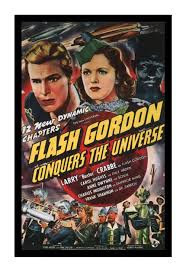 Since the motion picture industry's infancy in the nineteenth century, posters and billboards were the centerpiece of the studios' advertising campaigns. The first movie posters were simple outside placards listing the program being shown inside auditoriums, nickelodeons, and other public venues. The name of the film, the producer, and the director were listed. There were no movie stars yet. These handbills were distributed on the streets and posted outside businesses or wherever there was foot traffic to incite awareness and generate hype to sell movie tickets.
Since the motion picture industry's infancy in the nineteenth century, posters and billboards were the centerpiece of the studios' advertising campaigns. The first movie posters were simple outside placards listing the program being shown inside auditoriums, nickelodeons, and other public venues. The name of the film, the producer, and the director were listed. There were no movie stars yet. These handbills were distributed on the streets and posted outside businesses or wherever there was foot traffic to incite awareness and generate hype to sell movie tickets.The first movie poster was created in 1890 by French painter and lithographer Jules Cheret for "Projections Artistiques." In early Hollywood, playbills began illustrating a film's scene or an array of overlaid images from several scenes. Ordinarily, they contained a basic image and text with the film title in large lettering, sometimes with a tag line. Soon, actors' names were added to the posters.
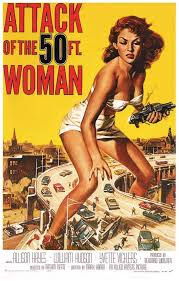 The illustrators were most often anonymous and did not sign their work. They were hired as studio staff. Prior to the 1990s, illustrations instead of photographs were far more common. Today's movie posters contain a billing block in small print at the bottom which includes an array of licensing and consumer information.
The illustrators were most often anonymous and did not sign their work. They were hired as studio staff. Prior to the 1990s, illustrations instead of photographs were far more common. Today's movie posters contain a billing block in small print at the bottom which includes an array of licensing and consumer information.Today, movie poster images are used on websites, DVD packaging, magazine ads, and movie databases. They can hint at the plot, highlight the stars, or offer an abstract representation of a key moment in the film.
Between 1940 and 1984, film posters were exclusively made and distributed by the National Screen Service. The advertising traveled with the film canisters from one exhibitor to the next. At the end of the film's run, the posters were returned with the film canisters and pretty beat up. Few survive intact. In the 1980s, the American film studios took over the direct production and distribution of their poster advertising and began to license the sale of poster reprints for fans. These have little or no value to collectors.
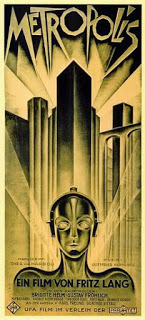 The first movie poster auction by a major house occurred on December 11, 1999. Today, original artwork and vintage posters command huge prices. The record price paid for a single poster was $690,000 for Fritz Lang's 1927 film Metropolis, far more than the original film cost to make.
The first movie poster auction by a major house occurred on December 11, 1999. Today, original artwork and vintage posters command huge prices. The record price paid for a single poster was $690,000 for Fritz Lang's 1927 film Metropolis, far more than the original film cost to make.Nine decades of movie posters are depicted with a brief explanation of trends for each decade. There are many fan favorites shown.
http://creativeoverflow.net/the-90-year-evolution-of-movie-posters/
Published on January 02, 2016 06:41
December 26, 2015
Happy New Year 2016--Why January First?
 New Year's Eve in Kiev, Ukraine.Historians have charted the origins of our New Year's celebrations to the ancient Babylonians four millennium ago. They marked the new year as the first full moon after the vernal (spring) equinox--sometime in March of our calendar.
New Year's Eve in Kiev, Ukraine.Historians have charted the origins of our New Year's celebrations to the ancient Babylonians four millennium ago. They marked the new year as the first full moon after the vernal (spring) equinox--sometime in March of our calendar.Traditionally, the Roman calendar attempted to follow the lunar cycle which frequently fell out of phase with the seasons. After consulting Sosigenes, an Alexandrian astronomer, Julius Caesar was advised to discard the lunar calendar and adopt the solar calendar, like the Egyptians had.
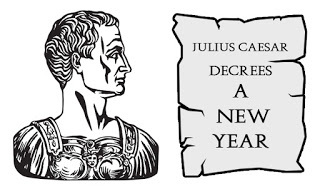 In 46 B.C., two years before his political assassination, Caesar added sixty-seven extra days to realign the Roman calendar with the sun. A year was calculated to be 365 and 1/4 days long.
In 46 B.C., two years before his political assassination, Caesar added sixty-seven extra days to realign the Roman calendar with the sun. A year was calculated to be 365 and 1/4 days long. Caesar decreed that every four years an extra day be added to February. He named the first month of the new calendar after Janus--the Roman god of beginnings. His two faces could look back at the past and forward to the future. While Caesar was at it, he also renamed the Roman month Quintilis to July, after himself.
The Julian calendar was replaced in 1582 when Pope Gregory XIII commissioned Jesuit astronomer Christopher Clavius to devise a more accurate calendar. There was an eleven minute error per year in the Julian calendar. The revised Gregorian calendar was implemented throughout Christendom and is the one we use today. Pope Gregory designated January 1st as the first day of the new year.
 New Year's Eve in Sydney, Australia.New Year's Eve is celebrated the last day of the Gregorian calendar--December 31st. Common traditions through much of the world include huge public gatherings, private parties, making resolutions, and fireworks displays. In English-speaking countries, "Auld Lang Syne" is sung at the stroke of midnight. The Robert Burn's song is based on a traditional Scottish phrase which is loosely translated as "long, long, ago" or "for old times."
New Year's Eve in Sydney, Australia.New Year's Eve is celebrated the last day of the Gregorian calendar--December 31st. Common traditions through much of the world include huge public gatherings, private parties, making resolutions, and fireworks displays. In English-speaking countries, "Auld Lang Syne" is sung at the stroke of midnight. The Robert Burn's song is based on a traditional Scottish phrase which is loosely translated as "long, long, ago" or "for old times." A tradition in America since 1907 is the giant ball drop in Times Square. The original ball weighed 700 pounds and was made of iron and wood. Today, the orb is 12 feet across and weighs 2,000 pounds. It is electrified with many thousands of LED lights producing millions of colors and billions of patterns.
A tradition in America since 1907 is the giant ball drop in Times Square. The original ball weighed 700 pounds and was made of iron and wood. Today, the orb is 12 feet across and weighs 2,000 pounds. It is electrified with many thousands of LED lights producing millions of colors and billions of patterns.One thing has not changed over the years. New Year's Eve lights the beacon to the future with hopes for a better year than the last.
Happy New Year, Everyone.
History Channel's short history of New Year's: http://www.history.com/topics/holidays/new-years
Published on December 26, 2015 05:44
December 15, 2015
The Coca-Cola Santa Story
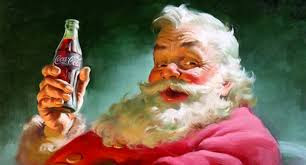
Santa's origin can be traced back to ancient Germanic folklore and the Norse god Odin. The modern character of Santa was embraced by America with the 1823 publication of Clement Clarke Moore's poem "A Visit from St. Nicholas"--better known as "Twas the Night Before Christmas." In 1881, political cartoonist Thomas Nast created the first Santa images based on Clement's fifty-six line poem.
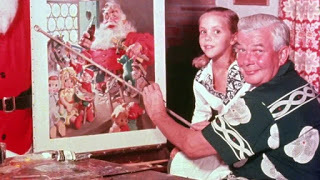 Haddon Sundblom at work.Michigan artist Haddon Sundblom painted the iconic image we now recognize as Santa Claus--for the Coca-Cola company from 1931 until 1964. These images appeared in Coke's print advertising, store displays, billboards, posters, calendars, and on television commercials. Sundblom helped make Santa the most recognizable and successful pitchman in advertising history.
Haddon Sundblom at work.Michigan artist Haddon Sundblom painted the iconic image we now recognize as Santa Claus--for the Coca-Cola company from 1931 until 1964. These images appeared in Coke's print advertising, store displays, billboards, posters, calendars, and on television commercials. Sundblom helped make Santa the most recognizable and successful pitchman in advertising history.The Coca-Cola Santa story: http://www.coca-colacompany.com/stories/coke-lore-santa-claus/
Published on December 15, 2015 05:27
December 8, 2015
Detroit's Movie Maven--Bill Kennedy
 Detroit Free Press TV Channel Guide print advertisement from the 1970s.
Detroit Free Press TV Channel Guide print advertisement from the 1970s.Every Baby-Boomer from Detroit and Windsor remembers who gave us our extensive Hollywood movie education--Bill Kennedy. Bill started announcing on the radio professionally in the 1930s at WWJ - The Detroit News station. His deep voice resonated over the air waves.
In 1940, he embarked on a movie career and signed a contract with Warner Brothers Studios where he worked from 1941 until 1955. Bill had the voice but not the face. He didn't emote well on screen, so he was relegated to a series of flat supporting roles. He played mainly cops, bad guys, radio announcers (no stretch for Bill), newspaper men, and swindlers. In all, Bill Kennedy has 103 film credits.
In the post World War Two era, Kennedy appeared on numerous B-Western television shows including The Lone Ranger, The Cisco Kid, and The Gene Autry Show. Kennedy always spoke kindly of Gene Autry. Bill was over six feet tall and many of Hollywood's leading men were short and didn't like doing fight scenes with him. Gene Autry was short, but always had a job for Bill when he needed it. Autry told him once, "I like beating up bad guys on screen who are bigger than me."
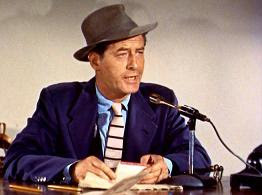 Bill Kennedy playing a newscaster in a Superman episode.
Bill Kennedy playing a newscaster in a Superman episode.What many of us in Detroit know that most people don't is Bill's was the voice behind the opening credits of The Adventures of Superman--one of the most iconic introductions in television history. Bill received a one-time check for $350. He regretted not asking for screen credit which might have benefited his career. The show has been continuously running in syndication since 1952. A link to the Superman program opening is below.
In 1956, Bill Kennedy returned to the Detroit area to host an afternoon movie program called Bill Kennedy's Showtime, for CKLW-TV across the Detroit River in Windsor, Ontario. The show became a big hit. Bill talked about his jaded experiences in Hollywood's heyday and how he worked with many of the top stars. His deadpan delivery and sarcastic wit won the loyalty of viewers. He had an avuncular, self-deprecating manner--especially if talking about a film he was in. If the movie was bad, he would tell his audience.
The show opened with a tight shot on a picture of a woman smoking a cigarette with Bill's theme song Just in Time playing in the background. The photograph was from a magazine. I can see the model in my mind's eye with her elbows on a table and a smoldering cigarette in her right hand. Bill chose Just In Time for his theme song because his professional life was at a low point when he got the job with CKLW.
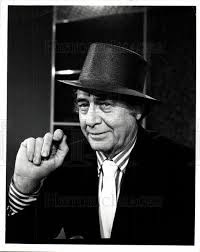 Bill wearing a hat to cover up his hair transplant surgery.In 1969, Bill took his show to WKBD which broadcast out of Southfield, Michigan. The show remained essentially the same with a title change to Bill Kennedy at the Movies. Bill would interview celebrities when they were in Detroit and he took on-air phone calls which were sometimes more interesting than the movies. I enjoyed the live TV commercial pitches of Abe Schroe for his furniture upholstery business.
Bill wearing a hat to cover up his hair transplant surgery.In 1969, Bill took his show to WKBD which broadcast out of Southfield, Michigan. The show remained essentially the same with a title change to Bill Kennedy at the Movies. Bill would interview celebrities when they were in Detroit and he took on-air phone calls which were sometimes more interesting than the movies. I enjoyed the live TV commercial pitches of Abe Schroe for his furniture upholstery business.Abe and Bill always had lively repartee like they knew each other well outside of work. These two got along so well on air that it strikes me Bill was probably part-owner or an investor in Artistic Upholstery. Bill would take a break and Abe would go into his pitch. Nobody else made live commercials on Bill's show--not Ollie Fretter--not even Mr. Belvedere (Detroit inside joke).
In 1983, Bill retired to Palm Beach, Florida. He died of emphysema on January 27, 1997, at the age of eighty-eight. Rest in peace "young, old-timer."
The Adventures of Superman introduction: https://www.youtube.com/watch?v=Q2l4bz1FT8U
Bill Kennedy's theme song Just In Time by Frank Sinatra. https://www.youtube.com/watch?v=RIcQ26arWAs
Published on December 08, 2015 06:48



